Continue your photo travel tour with Joan Ubide, while he’s on his photographic discovery of Tibet.
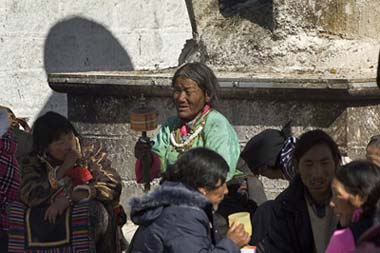
Copyright 2007 Joan Ubide
Outside Jokhang Temple in Lhasa
1/640 F/6,3 Iso: 125, 210 mm
If you love the mountains, serenity, and shocking situations, and are willing to set aside all luxuries–including not having a hot shower for several days–then Tibet can be your next destination. The first big “flash” is in Lhasa, the capital. Walking along the streets that surround the Jokhang temple is astounding. Hundreds and hundreds of pilgrims arriving from every corner of the country gather there. They devote hours to meditating and praying with their prayer wheels and worn-out beads. They’re humble, poor people. They wear dirty clothes; their skin is cracked; and their cheeks glow pink with cold. Some of them have spent days, weeks, or even months on their pilgrimage to the capital. What is really astonishing is that they make the journey according to a ritual: they walk two steps, kneel, lie down to pray, stand up again, and repeat for long, innumerable days.
The temples of the city are a must-see, especially Potala and Jokhang (in the center), a good place to sit down and let the hours go by as you watch the pilgrims praying in front of the white walls. You can’t miss the Ganden temple (one hour from the capital, 300 RMB by taxi for 30 Eur). It stands at a height of 4.300 m. and is spectacular if you can get there at about seven in the morning to watch the sun rise above the slopes of the mountain. At around eight in the morning,
the monks start to wander around. You have to follow them, because they go to the main room to pray and drink tea, while the younger monks run up and down with their thermos bottles to serve all the guests.
Palhalupuk is a small, relatively unknown temple, but it deserves a visit. You can find in front of Potala, under the mountain where the communications tower of Lhasa is. There are no signs to show you the way. I found it by chance. In contrast, at Sera temple, in the northwest, everyday at 3:00 all the monks meet in the park to test their knowledge with questions shouted at full blast accompanied by their characteristic clapping. This is how they keep their knowledge and culture up-to-date. Tourists can take pictures, but I recommend that you record a video, as the event is something really unique. You can readily see the humanity and kindness of these people.
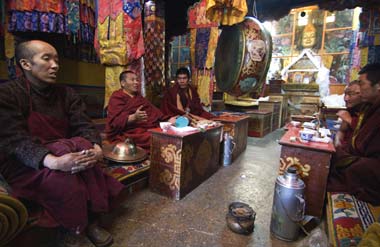
Copyright 2007 Joan Ubide
Sera Temple in Lhasa
0,3 F/4, Iso 320, 12 mm
At this stage of my lengthy journey, I’ve already experienced several very special moments. One of them was in the Sera temple. I walked into one of the large meditation rooms, and the monks invited me to join them and drink tea. As I stared around the room with my tourist’s eyes, they seemed amused. I was sitting under a big gong in a place that I had seen before in documentaries.
A second special moment happened at the Jokhang temple. I was sitting people-watching and taking pictures of those praying at the walls of the temple when I saw an old lady coming towards me, very, very slowly. One of my footsteps was like ten of hers. We looked at each other. She sat next to me, held my hand, and started praying. She was there with me for half an hour, as I watched her smiling face, feeling how she touched my hand. I have to admit that this encounter touched me and instantly made this part of my trip worthwhile. However, another great moment was, without a doubt, when I could admire the Himalayas and see the most starry night of my life in the foothills of Mount Everest, although at minus 25 degrees Celsius (minus 15 degrees inside the room).
In short, Tibet is a really poor and abandoned region. People live as they did decades ago. In small towns, they have donkeys instead of cars, and they warm water for tea with solar panels. However, they’re very nice. They look at you and smile, and those who have less are those who give more. The children are happy, but their situation is sad. Their vocabulary is limited to “hello” and “money.”
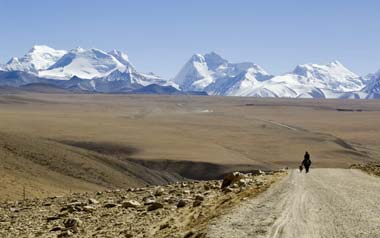
Copyright 2007 Joan Ubide
Himalayas View
1/125 (-0,33) F/16, Iso: 100, 70 mm
Details and tips to travel from Tibet to Nepal
If you have a large budget, traveling to Tibet is easy. You can simply contract the trip with all the necessary permits from your hometown and spend lots of money doing it. However, I recommend you approach this trip a little differently. You can pay the same amount of money and visit China first, arriving on a low-cost flight. Then you can take your time (maybe a month) reaching this region. The easiest, most popular route runs from Beijing to Chengdu and then to Lhasa. You travel in new trains that are pressurized (like planes) because they go through very elevated areas. (Lhasa is at a height of 3.595 m.)
Speaking of elevated areas, be careful with high altitudes, especially if you’re not used to being in high mountains. The experience can be really unpleasant. Altitude sickness, a sensation of asphyxia, and anxiety are possible, especially when you get reach higher elevations. Take medicines with you. Dizziness, nausea, diarrhea can be your travel companions.
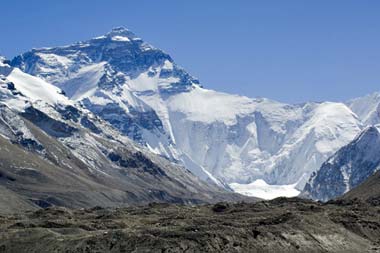
Copyright 2007 Joan Ubide
Everest BC
1/160 F/16, Iso: 160, 70 mm
As you plan your trip, September (21º to 7º) and October (17º to 1º) can be good months to visit the region. Temperatures are bearable, but it’s cold at night and can snow. In Lhasa, you can buy technical winter clothes at very good prices, but you have to ask for a discount–usually up to 50%. The clothes are not authentic brands, but they work and look okay. Temperatures in November range from 13º to -5º. Potential conflict makes March (12º to -2º) less than desirable as a time to visit. In March, some of the locals celebrate the anniversary of the Tibetan revolution and the exile of the Dalai Lama (in 1959), so you may encounter difficulties obtaining permits to move around the area. From May (19º to 5º) until June (24º to 9º), take into account that the weather is “windy.” In August (26º to 10º), there are too many tourists.
Permits to enter Tibet
The task of obtaining your permits can vary according to the political situation in China. As a rule, you need a permit to get to Lhasa. (Note: If you travel by train, no one asks you for it!) It costs 800-500 Yuan (80-50 Eur). I recommend you get the permit in Beijing, because it’s probably cheaper there. Be prepared for unexpected problems. For example, I had to hire a driver to go from the airport of Lhasa to the city, because President Bush had just given a medal to the Tibetan people. Reacting to the medal, the next day the Chinese Government imposed a new rule for tourists. I could no longer ride a normal bus, which was ten times cheaper.
.jpg)
Copyright 2007 Joan Ubide
Tashilunpo Temple in Shigatse
1/60 F/5, Iso 400, 125 mm
If you travel to Tibet by plane, especially from China, you need a permit. There are controls, and you’re asked to show the permit three times. If you don’t have one, you don’t get on the plane. To move around the country, you need another permit. The price varies according to the route you want. Take into account that you can’t visit Tibet by yourself. You can try–some people do it–but bus drivers won’t sell you tickets, as they can be punished for it. You must always be accompanied by a driver and a guide. If you don’t follow these rules, you run the risk of being stopped by a police control and sent back to Lhasa.
There are several travel agencies. I recommend Snowland in the Hotel Snowland in Lhasa (first floor). The drivers and guides are nice Tibetan people, but you have to be very clear that you want to stop as many times as you want and travel without hurrying. The drivers and guides aren’t very concerned with complying with the decisions of their customers once they’re on the road. The prices are okay, and the vehicles in good condition. However, you have to reprehend the driver if you see he’s going too fast when you’re riding close to cliffs.
Contracting the service from Lhasa to the frontier with Nepal will cost you 5.500 Yuan (550 Eur), permit included. You can share the cost with four people. If you can’t find a travel companion, publish an ad in the Lonely Planet forum, and you’ll find people very easily (http://thorntree.lonelyplanet.com). It takes five to six days to complete the route. The highlight of the trip is the visit to the Everest base camp crossing the Himalayas, something you’ll probably do only once in a lifetime. In Lhasa you can sleep in the Banak Sholl Hotel, in Beijing Road (good atmosphere, excellent food and beds at around 4 Eur). You have to try the restaurant Tashi, run by a Tibetan family. They serve local specialities at good prices. Sleeping in these cities costs around 40 Yuan (4 Eur/night). The toilets are usually a simple hole in the ground, and few of them have hot water. In big cities, you can find more comfortable hotels. Just talk about it with your guide. (I prefer to spend my money traveling for more days.)
The route Lhasa / Nepal:
1st day, from Lhasa to Lake Yamdrok-Tso – Gyantse (7 hours)
2nd day, Gyantse – Shigatse (3 hours)
3rd day, Shigatse – Shegar (6 hours)
4th day, Shegar – Rongbug base camp of the Everest (4 hours) (access to the base camp costs around 250 Yuan (25 Eur)
5th day, Rongbug – Tingri (5 hours)
6th day, Tingri – Hangu (7 hours)
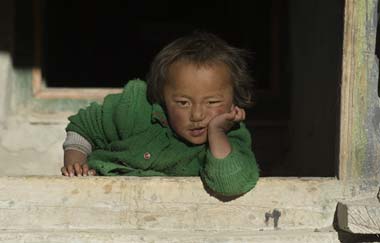
Copyright 2007 Joan Ubide
Child in Tingri
1/320 F/8, Iso: 160, 135 mm
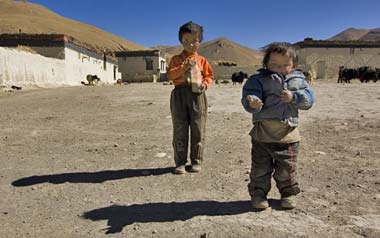
Copyright 2007 Joan Ubide
Children in Village near Tingri
1/180 F/11, Iso: 100, 20 mm
The Nepal border opens at around nine in the morning, and the road is total chaos.
You can get a visa to Nepal in the consulate in Lhasa (Norbulikngka Road 13). The visas (around 250 Yuan–25 Eur–for 60 days) are issued on working days from 10 to 12 a.m. It’s advisable to be there at 09:30 to queue. You need a picture and will also have to fill out a form. If you don’t have a picture, there’s a small stall a few meters from the consulate where a guy will take four photos of you for 15 Yuan (1,5 Eur), and give you a toothless smile for free. The visas are delivered the next day, from 4:00. Once in Nepal, you can extend your visa very easily. You can also purchase a visa at the border, but I recommend you get it beforehand to avoid waiting.
That’s all for Tibet. At this writing, I’m in Kathmandu (Nepal), where I’ll spend a month. By mid-December, I’ll start a two-month route through India, and
then head to Southern Asia, where I hope I’ll find a lost beach where I can rest for a while, wearing a bathing suit and flip-flops all day!
Tashi Delek
Joan
To see more photos on Joan’s trek through Tibet visit…
www.joanubide.com
Visit Part 1: Mongolia
Visit Part 2: China
Visit Part 4: Nepal
Visit Part 5: North India
Visit Part 6: South India
Visit Part 7: Iran
by Joan Ubide

Leave a Reply